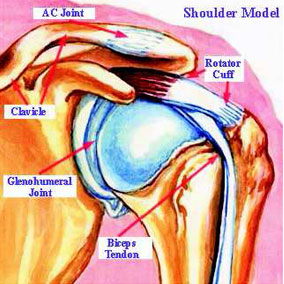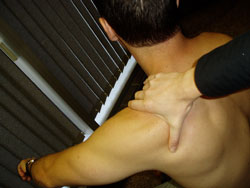 The rotator cuff is a group of tendons and muscles which attach the upper arm to the shoulder blade. It helps you lift, push, pull, throw, and reach with the arm. The rotator cuff is a common cause of shoulder pain. Pain due to the rotator cuff can occur when the muscles and tendons are inflamed, compressed, or torn.
The rotator cuff is a group of tendons and muscles which attach the upper arm to the shoulder blade. It helps you lift, push, pull, throw, and reach with the arm. The rotator cuff is a common cause of shoulder pain. Pain due to the rotator cuff can occur when the muscles and tendons are inflamed, compressed, or torn.
Injury to the rotator cuff is more likely to occur with physical activities that require repeated overhead movement (above shoulder level) such as tennis, golf, swimming, weight lifting, or overhead work.
The tendon of the supraspinatus, one of the rotator cuff muscles, passes beneath the bone, which you feel on the top of the shoulder, called the acromion. In some individuals, the space beneath the acromion is quite narrow or can narrow due to faulty shoulder movement, injury, or inflammation. This can cause the rotator cuff tendon to be compressed or impinged when the arm is raised, which may be painful. If impingement persists, it can lead to swelling and adhesions/scarring of the rotator cuff. In severe or traumatic cases, it may lead to a muscle or tendon tear.
Common Symptoms of a rotator cuff injury
Pain primarily on top and in front of the shoulder, sometimes it can be felt at the side of the shoulder. Usually, it is worse with overhead activities. The pain can also make it difficult to sleep on the affected shoulder.
Weakness may be felt, especially with overhead activities
Popping: bursitis or tight soft tissues which may occur with a rotator cuff injury can cause mild popping or crackling sensations in the shoulder.
 Treatment of rotator cuff injury
Treatment of rotator cuff injury
When a mild to moderate rotator cuff injury is diagnosed a period of rest, ice and therapy will frequently decrease the symptoms. Rehabilitation exercises and stretches to enhance shoulder biomechanics will reduce reoccurrence.
It is important to consult a health professional in order to receive a proper diagnosis and appropriate treatment.
How Active Release Therapy (ART) can help resolve shoulder pain
When muscles, tendons, and surrounding soft tissues become inflamed or compressed, it can cause adhesion/scarring in the tissues. This results in shortened and weakened muscles and tendon, which can restrict the shoulder from working properly.
When adhesions and scar tissue are involved, ART can be used to release these restricted areas by breaking down the scar tissue. This will help the muscles and tendons of the shoulder to move freely, correctly and pain free.

